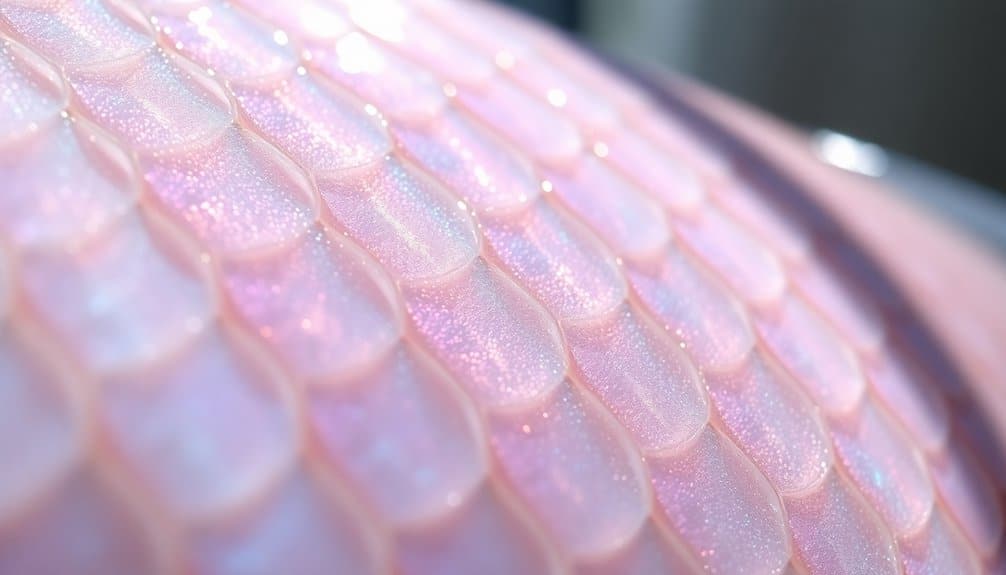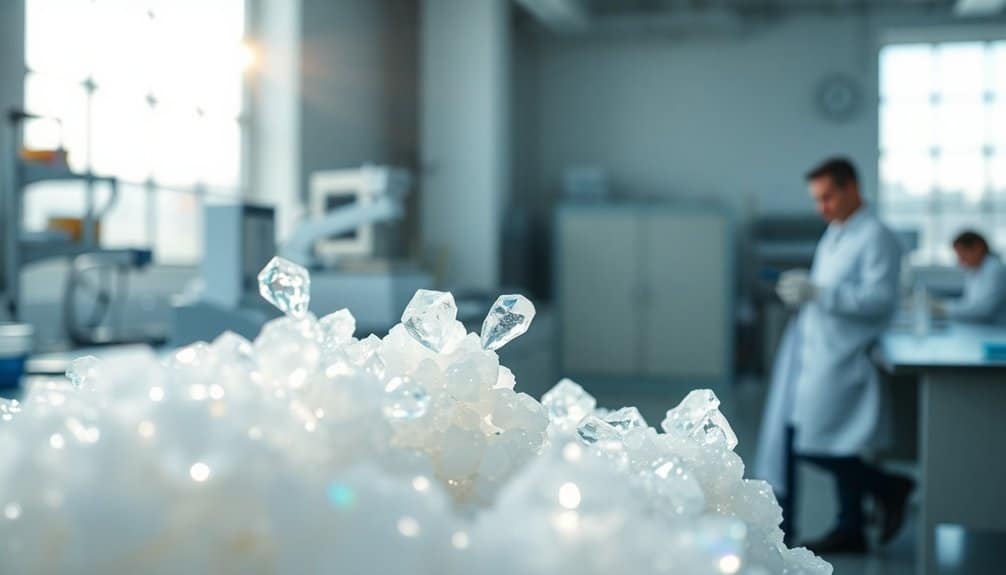The radiant glow you’ve admired in cosmetics often stems from guanine, a remarkable ingredient that enhances the beauty of your favorite products. This natural compound, found in fish scales, offers a unique pearlescent effect, capturing and reflecting light in a captivating manner.
It’s an ancient secret of elegance that speaks to the natural world’s ability to illuminate. In the realm of beauty care, understanding guanine’s properties invites a deeper appreciation of how it transforms ordinary makeup into something extraordinary. This iridescent quality not only enhances appearance but also embodies a connection to nature’s artistry.
By embracing guanine in makeup formulations, brands bring forward a tradition that celebrates beauty through transparency and luster. As with any element of beauty, balance is key. Guanine shines brightest when combined thoughtfully with other ingredients, ensuring that the final product maintains integrity without overwhelming the skin.
This harmonious blend reflects a principle that resonates throughout traditional beauty practices: enhancing one’s natural glow rather than masking it. Embracing this knowledge allows for mindful choices. Selecting products that feature guanine is not just about the allure of shimmer; it’s about integrating a piece of nature’s legacy into your beauty routine.
A mindful approach to beauty fosters not only external radiance but also nourishes the spirit, echoing the wisdom of traditions cultivated through the ages.
Table of Contents
Toggle
Imagine the delicate shimmer of a fish’s scales as they capture sunlight beneath the water’s surface, casting glimmers of silver and gold that evoke a certain charm. This enchanting display is attributed to guanine, a natural substance whose properties can be harnessed to create your own striking effects of light and color.
Guanine crystals function as nature’s intricate light mechanisms. These exquisite structures range in size, with each variation producing distinct visual experiences. Larger crystals, measuring between 5 and 70 micrometers, yield dramatic pearlescent effects that cause surfaces to gleam with richness. The light dances between the layers of these crystals, generating interference patterns that create those captivating flashes.
On the other hand, if you’re seeking a pure white appearance, the smaller crystals—those under 5 micrometers—are your best bet. They scatter light in a manner that produces bright white effects without the added shimmer of color. One could think of it as the difference between a glittering ornament and a fine, uniform paint; both serve their unique purpose within the artistry of creation.
To achieve optimal results, consider the method of crystal growth carefully. Employing lower concentrations and gradual pH adjustments allows for the formation of fewer yet larger crystals that harmonize beautifully. This approach results in radiant, pearl-like effects that are difficult to overlook.
What truly sets guanine apart is its remarkable capacity to bend light. Its crystal structure organizes into dense layers that reflect light with great efficiency, akin to a myriad of tiny mirrors arranged in perfect alignment. The refractive index of anhydrous guanine reaches approximately 1.85 in one direction, making it significantly more light-bending than water.
The dynamic potential of these crystals is among the most intriguing aspects of guanine. In nature, for instance, fish like neon tetras can tilt their crystalline layers, allowing for instantaneous color shifts. This function is known as the “Venetian blind” model, where the crystals act like adjustable blinds, modulating the passage of light and color.
To elevate the natural qualities of guanine, one might consider incorporating fluorescent materials. While guanine does not emit light on its own, integrating specific dyes into its structure allows for a combination of shimmer and fluorescence. This technique keeps the dyes from clumping, thereby maintaining their brilliance.
The development of fluorescent guanine materials unveils new potential for creating vivid displays, particularly in blue-hued settings. Whether your interest lies in artistry, materials science, or a deeper understanding of nature’s exquisite beauty, guanine crystals offer a captivating means of manipulating and mastering light.
Guanine possesses a commendable safety record for topical applications, earning its classification as a color additive exempt from certification by the FDA. This designation is not given lightly; it follows a thorough review of extensive safety data, ensuring it meets rigorous safety specifications. Evaluations reveal minimal risks associated with its use in compliance with FDA regulations. Notably, guanine does not present concerns related to carcinogenicity, mutagenicity, or reproductive toxicity. The Cosmetic Ingredient Review (CIR) acknowledges this established safety, allowing independent assessments to be deferred.
Certainly, guanine is approved for use in cosmetics designed for the delicate eye area. The FDA regulations under sections 73.1329 and 73.2329 explicitly permit guanine in eye cosmetics and some externally applied drugs. Its stable chemical properties and compatibility with various cosmetic formulations make it an excellent choice for enhancing the appearance of products like eye shadows by providing subtle pearlescent effects.
Guanine is strictly for external applications only. While it enjoys approval for cosmetics and topical drugs, its use is not permitted in oral drug products due to a lack of safety data regarding internal applications. The FDA regulates the concentrations of guanine in cosmetics to ensure it remains both effective and safe, protecting consumers from any potential skin reactions. Adhering to these guidelines is essential for maintaining safety in its topical use.
You will find guanine to be highly compatible with a variety of cosmetic ingredients. It typically does not produce adverse reactions with preservatives, stabilizers, or UV filters found in formulations. This stability means that guanine can be effectively incorporated into diverse products, maintaining the quality and efficacy of the other active ingredients, and allowing for the creation of intricate formulations.
Indeed, guanine in nanomaterial form faces heightened regulatory scrutiny, particularly in Europe under Cosmetics Regulation (EC 1223/2009). Such materials must undergo mandatory pre-market notifications to regulatory authorities six months prior to market introduction. Specific labeling procedures and enhanced safety assessments are also required, evaluating factors such as particle size and potential skin penetration. The Scientific Committee on Consumer Safety (SCCS) continually updates guidance on the safety assessment of nanomaterials.
Guanine is celebrated for its role as a pearlescent pigment, granting luminosity and optical brightening effects in various formulations. You will notice its impact in products such as eye shadows and lipsticks, where it contributes iridescent properties that enhance visual appeal. Its consistent performance across different formulation types makes guanine a valuable ingredient for achieving desired aesthetic effects while upholding quality and safety. This crystalline material is originally derived from fish scales through specialized extraction processes.
Guanine benefits from an exemption from the batch certification typically required for other color additives by the FDA. This exemption simplifies its application in approved uses listed under specific sections of the Code of Federal Regulations. Still, it must conform to strict safety specifications and is permanently documented with comprehensive regulations governing its permissible uses in cosmetics and drugs.
The safety of guanine is underscored by extensive reviews conducted by the FDA before its classification as exempt. Current toxicological assessments confirm the lack of significant risks for topical applications, with no evidence of adverse effects like carcinogenic or mutagenic issues. Its safety profile is bolstered by evaluations of skin compatibility, particularly in sensitive areas such as around the eyes, reinforcing its suitability for various cosmetic formulations.
Standard labeling requirements apply to products containing guanine, particularly when it is in nanomaterial form, which necessitates additional disclosure to align with evolving European safety standards. Such requirements enhance consumer transparency and ensure regulatory compliance, especially in an industry where safety guidelines are continually evolving.
Regulatory authorities remain vigilant in monitoring the safety of guanine through ongoing research and the adaptation of guidelines, especially regarding nanomaterial forms. The FDA oversees these regulations closely, while the SCCS provides updated insights on safety assessments. This systematic approach ensures that safety standards keep pace with new scientific data and research developments pertaining to guanine’s use in cosmetics.

In the realm of beauty, as brands increasingly seek to honor the planet, new avenues for guanine production emerge, stepping away from the traditional practice of using fish scales. Notably, scientists have developed chemical techniques that allow for the creation of high-quality guanine within laboratory settings. This innovation provides brands with enhanced control over both purity and consistency, ensuring reliable quality in their products.
Biotechnology opens yet another path, employing microbes and enzymes for sustainable guanine production. This method entirely avoids animal-derived ingredients, aligning beautifully with the principles of vegan and cruelty-free skincare that many seek today. The crystalline structure of guanine enables its remarkable light-reflecting properties that create the desired iridescent effects in cosmetic formulations.
These advancements present an opportunity to achieve a luxurious, pearlescent finish in cosmetics while remaining mindful of our environmental responsibilities. The production methods not only deliver aesthetic appeal but also safeguard marine life, balancing beauty with ecological stewardship. This thoughtful approach reflects a deep respect for nature while embracing modern techniques.